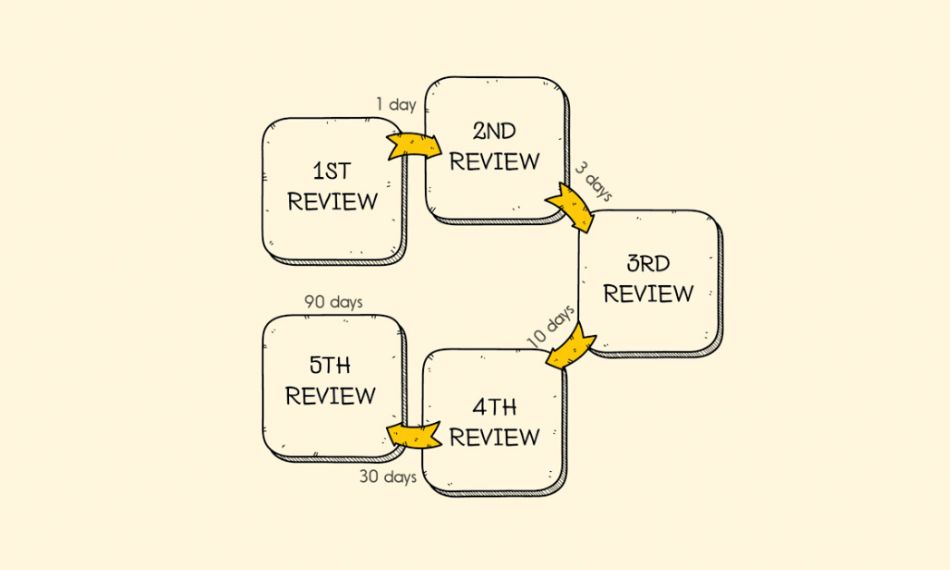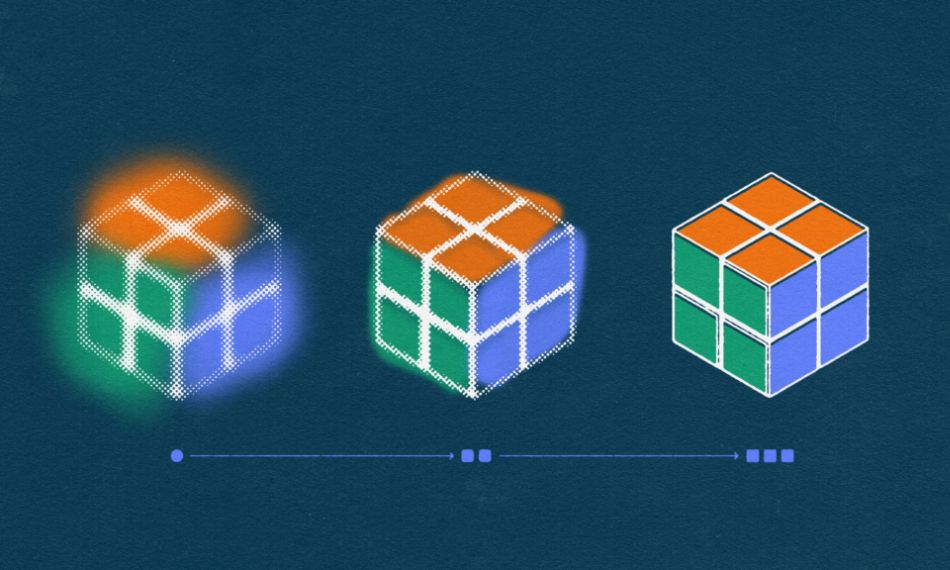What is Spaced Repetition?

Spaced repetition is a learning technique that involves reviewing information at increasing intervals over time. Instead of repeating content again and again in one sitting, spaced repetition brings it back just before you’re about to forget it.
This timing is key—it strengthens your memory and keeps forgetting at bay. The idea is backed by the “forgetting curve,” a concept introduced by psychologist Hermann Ebbinghaus. He found that we forget new information quickly unless it’s actively reinforced.
Spaced repetition turns short-term knowledge into long-lasting mastery.
How Does Spaced Repetition Work?

Spaced repetition works by strategically timing your reviews to maximize memory retention. Instead of reviewing information all at once (like in cramming), you space out your review sessions based on how well you remember each item.
Here’s how it works step by step:
-
You learn something new.
For example, a new vocabulary word or a fact. -
You review it soon after learning.
This first review helps reinforce the memory before you forget it. -
You review it again after a slightly longer interval.
If you still remember it, the next review gets scheduled even later—maybe a few days or a week. -
If you forget it, the app resets the interval.
This helps you relearn it until it sticks. -
Each successful recall strengthens your memory.
Over time, you need fewer and fewer reviews to remember the item.
Example Timeline:
-
Day 1: Learn the word “ubiquitous.”
-
Day 2: Review it.
-
Day 4: Review again.
-
Day 7: Review again.
-
Day 14: Review again.
-
Eventually: You remember it for life.
Apps like GuruLango automate this entire process using smart algorithms—so you focus on learning, not planning.
Benefits of Spaced Repetition
Spaced repetition isn’t just a study trick—it’s a powerful learning strategy backed by science. Here are the top benefits:
- Improves Long-Term Memory: By reviewing information right before you forget it, spaced repetition strengthens your memory and helps you retain knowledge for weeks, months, or even years.
- Saves Time: Instead of constantly re-reading everything, you focus only on what you’re close to forgetting. That means less study time, but more impact.
- Reduces Mental Overload: Cramming dumps too much info into your brain at once. Spaced repetition breaks learning into smaller chunks, making it easier to absorb and recall information.
- Boosts Learning Efficiency: You learn smarter—not harder. With fewer but more effective reviews, your study sessions become ultra-efficient.
- Works for Any Subject: Whether you’re learning vocabulary, math formulas, historical dates, or medical terms, spaced repetition helps you retain any kind of information.
- Easily Integrated with Apps: Spaced repetition apps like GuruLango automate the process, making it easy to stick with daily reviews without having to track anything manually.
- Reduces Stress: When you know the material is coming back at just the right time, you worry less about forgetting—and feel more confident going into tests, presentations, or real-life conversations.
Why Spaced Repetition Works So Well in Language Learning

Language learners thrive with this learning method because vocabulary is everything. You need to recall words weeks or months later—not just after one study session. This method trains active recall, helping words stick for real use. It also builds consistency with short, spaced reviews, making it easier to stay motivated without burning out or wasting effort.
Spaced Repetition vs. Cramming: A Quick Comparison Table
| Feature | Spaced Repetition | Cramming |
| Memory Retention | High – Information is reviewed just before forgetting, strengthening long-term recall. | Low – Most of what’s learned is forgotten soon after the session. |
| Time Efficiency | Smart use of time – Reviews focus only on material you’re about to forget, avoiding unnecessary repetition. | Wastes review – Covers everything, even well-known material, leading to inefficient use of time. |
| Long-Term Benefit | Strong – Knowledge is transferred to long-term memory with fewer but more meaningful reviews. | Weak – The retention is short-lived, requiring constant revisiting. |
| Stress Level | Lower – Regular, low-stress reviews prevent last-minute cramming, reducing anxiety. | High – Cramming is stressful and overwhelming, often leading to burnout. |
| Customization | Highly personalized – Spacing intervals adjust based on individual performance and difficulty. | One-size-fits-all – All material is treated the same, without adapting to difficulty. |
| Engagement | High – Keeps you engaged with interactive review cycles and progress tracking. | Low – Often monotonous, as it’s usually just reading or repeating the same material under time pressure. |
| Learning Efficiency | Very high – Focuses on reinforcing memory at optimal intervals, making each review session more effective. | Low – Many reviews are repetitive and not timed correctly for maximum learning. |
| Tools Commonly Used |
Flashcard apps (e.g., GuruLango, Anki, Quizlet), planners | Notes, summaries, and late-night sessions |
If you’ve ever crammed for an exam and forgotten everything the next week, you already know the problem. Spaced repetition fixes that.
How GuruLango Uses Spaced Repetition?

- Flashcard Apps
Flashcard apps like Anki and Quizlet are popular tools for spaced repetition learners. They allow users to create their own decks and schedule reviews based on intervals. However, they require manual setup and customization, which might not be ideal for those who want a quick, efficient learning experience without spending time on deck creation.
- Study Platforms Like GuruLango
GuruLango streamlines spaced repetition by integrating it directly into your language learning path. It personalizes review intervals based on your performance, offering intuitive reminders and adaptive schedules. With real-world usage contexts and language-specific optimization, GuruLango provides an efficient, stress-free way to learn, designed by experts for practical language retention.
- Paper-based SRS Systems (Leitner Box, etc.)
Paper-based spaced repetition systems, like the Leitner Box, are an older method for learning. While they are effective, they require manual sorting of flashcards into boxes based on difficulty. This can be cumbersome and less efficient than digital tools. Though still valuable, paper-based systems lack the convenience and adaptability of modern apps like GuruLango, which automate the review process based on individual performance and learning needs.
Tips to Start Using Spaced Repetition Today

- Choose your focus: Whether it’s vocabulary, grammar, or sentence structures, identify your key learning areas and focus your spaced repetition reviews there.
- Use an SRS-powered tool like GuruLango to save time setting up your study materials. The system takes care of the scheduling for you, maximizing efficiency.
- Be consistent: Make short, daily reviews part of your routine. It’s better to practice a little each day than cram all at once, which is ineffective in the long run.
Conclusion
Spaced repetition is a powerful, research-backed method that enhances memory retention, saves time, and reduces stress. By integrating this learning approach into your learning routine with tools like GuruLango, you can build knowledge more efficiently and retain it for the long term.
FAQ
1. What is the 2 3 5 7 study method?
The 2-3-5-7 method is a simple spaced repetition schedule. You review new material after 2 days, then 3 days later, then 5, and finally 7 days apart.
2. How to do spaced repetition properly?
To use spaced repetition effectively, review information right before you’re likely to forget it. Start with frequent reviews (e.g., same day or next day), then gradually increase the interval (3 days, 7 days, etc.).
3. What is the best schedule for spaced repetition?
There’s no one-size-fits-all schedule, but common intervals are: 1 day, 3 days, 7 days, 14 days, and 30 days. Adjust based on how well you remember—shorter gaps for hard items, longer for easy ones.